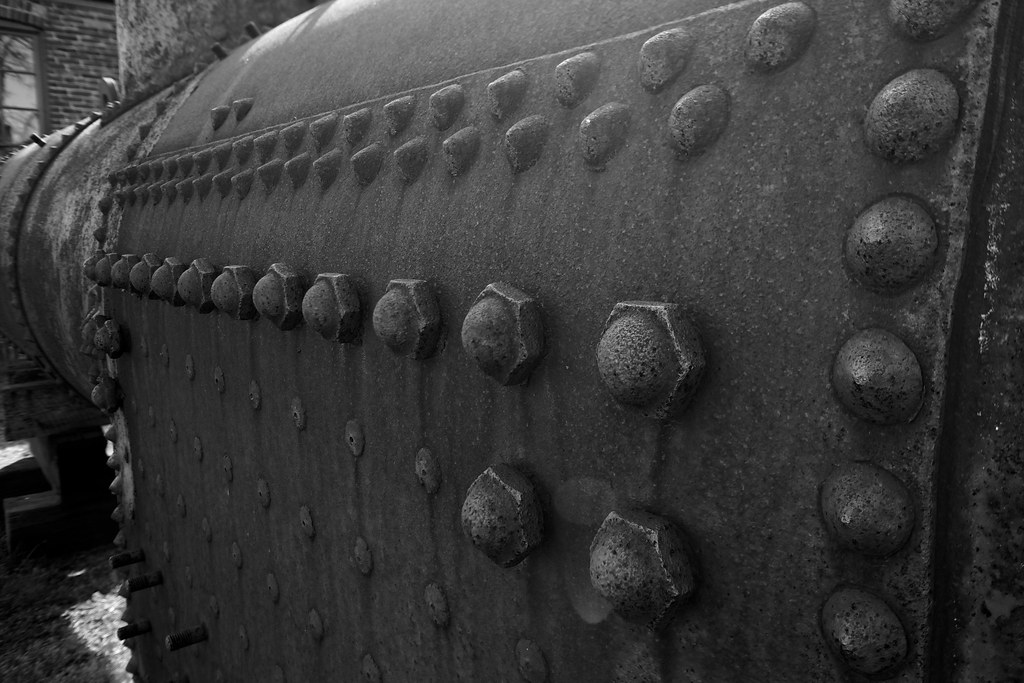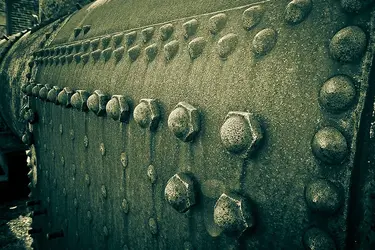TCampbell
Been spending a lot of time on here!
- Joined
- Mar 31, 2012
- Messages
- 3,614
- Reaction score
- 1,558
- Location
- Dearborn, MI
- Can others edit my Photos
- Photos OK to edit
Having more fun with the tilt-shift lens... I found this old boiler in Greenfield Village -- lots of rust and I knew I had to capture the texture and make a B&W with this.
The first time I did this, I didn't have my tilt-shift. I could not get a satisfactory depth of field (remember... I'm going for texture so I don't want this going mushy on me.) That was last fall. So this spring (actually just a couple of weeks ago) I headed back, but this time I brought the tilt-shift lens.
There's a bit of a tendency for people to use tilt-shift basically backwards (deliberately shift the plane of focus to make a very narrow DoF to create a "miniature" effect.) That's a bit easier because you don't have to be careful about angle settings. I wanted to use the tilt for it's intended purpose... bring the plane of focus in line with my subject's surface to maximize the DoF. That's a bit trickier and takes some practice with the lens (there is a method for doing this by eye and also a math formula which allows you to calculate the precise tilt angle (I can share that formula if anyone is interested.))
So here's the image...

Boiler by Tim Campbell1, on Flickr (you can see this is in a much larger size by clicking to view it at Flickr)
I don't want to bias anyone's opinion, but there's one aspect of this image that does bother me. So without telling you what it is... I'm considering one particular edit. But I'd like to hear other suggest what they might do (because if I say what it is, you'll probably all gravitate to it.)
The first time I did this, I didn't have my tilt-shift. I could not get a satisfactory depth of field (remember... I'm going for texture so I don't want this going mushy on me.) That was last fall. So this spring (actually just a couple of weeks ago) I headed back, but this time I brought the tilt-shift lens.
There's a bit of a tendency for people to use tilt-shift basically backwards (deliberately shift the plane of focus to make a very narrow DoF to create a "miniature" effect.) That's a bit easier because you don't have to be careful about angle settings. I wanted to use the tilt for it's intended purpose... bring the plane of focus in line with my subject's surface to maximize the DoF. That's a bit trickier and takes some practice with the lens (there is a method for doing this by eye and also a math formula which allows you to calculate the precise tilt angle (I can share that formula if anyone is interested.))
So here's the image...

Boiler by Tim Campbell1, on Flickr (you can see this is in a much larger size by clicking to view it at Flickr)
I don't want to bias anyone's opinion, but there's one aspect of this image that does bother me. So without telling you what it is... I'm considering one particular edit. But I'd like to hear other suggest what they might do (because if I say what it is, you'll probably all gravitate to it.)
Last edited:








![[No title]](/data/xfmg/thumbnail/39/39460-55f4d48e22a9710f377f2a3dee45992e.jpg?1734173551)
![[No title]](/data/xfmg/thumbnail/39/39447-6e7679723d775935851f055bae9712ba.jpg?1734173538)





![[No title]](/data/xfmg/thumbnail/35/35587-16c570d2927f2a9ea1945320686eca01.jpg?1734167214)